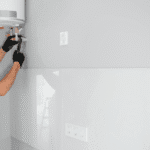Last Updated on July 19, 2024 by Asfa Rasheed
Certain software in security camera technology, like license plate recognition systems for checkpoints or parking lots, offers numerous advantages. These systems can detect traffic in parking areas or at electric gates and compare camera images to a database for enhanced security and efficiency.
Data is stored on the server, allowing for easy retrieval and comparison. Additionally, alerts can be sent via email or directly to a mobile device, customizable to meet the specific needs of customers who purchase these security camera systems designed for vehicle monitoring.
Table of Contents
Maximizing Efficiency: Ideal Camera Angles and Distances for License Plate Recognition
The camera must meet specific parameters for the license plate recognition system to function effectively. Firstly, the camera’s angle is crucial; a camera positioned too high cannot capture clear images of license plates. The distance between the camera and the vehicle is also important, although the camera can zoom in to compensate for longer distances. Lighting is another key factor—whether you use built-in infrared or additional flashlights, adequate illumination is essential, especially at night.
Unlocking Efficiency: The Benefits of License Plate Recognition Systems at Checkpoints
There are numerous advantages of license plate recognition systems at checkpoints and parking lots. These systems ensure constant supervision and proper parking lot or barrier management. They facilitate rapid identification, enabling a smooth and delay-free flow of vehicles entering and exiting. This technology enhances security by swiftly locating suspicious vehicles or individuals, providing complete safety for tenants, employees, and owners. Additionally, it assists in tracking stolen vehicles involved in crimes and enforcing parking regulations, such as time limits and reserved spaces.
Cut Costs with Advanced LPR Systems
Many parking lots have operated with a permanent guard during the day and another at night, leading to higher expenses. However, it is now possible to manage parking lots, control barriers, and operate electric gates more efficiently without additional personnel. By hiring an external company to gate repair Los Angeles, ongoing control and database maintenance can be achieved, resulting in reduced financial expenses on staffing. The LPR system technology has significantly reduced the need for human resources and allows for greater accuracy in document verification, leading to better security.
Seamlessly Integrates with Existing Solutions
LPR technology can seamlessly integrate existing solutions, enhancing control systems, management, and user experience.
What is the range for detecting LPR cameras?
The detection range varies significantly among different models. Common models can recognize vehicle license plates from distances ranging between 82 and 164 feet.
The History of LPR
The earliest record of a system utilizing LPR (License Plate Recognition) technology dates back to 1976. This system was developed by the scientific branch of the English police to enhance control and security measures. The first operational use occurred in 1979. The initial model featured high-quality cameras linked to a robust external processor capable of efficiently handling optical data.
The foundation of the technology remains the same, but all its components have become smaller, stronger, and more efficient. It is now smarter, able to learn from experience and solve complex problems with greater accuracy, and its enhanced capabilities suit a wider range of applications.















